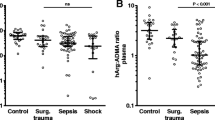Abstract
Nitric oxide (NO) acts as a vasorelaxant. We investigated the relationship between nitrite/nitrate (NOx), which are the final metabolites of NO, and hemodynamics during septic shock. We also examined tumor necrosis factor α (TNF-α), interleukin-8 (IL-8), and endotoxin. A significant negative correlation was observed between NOx levels and pulmonary capillary wedge pressure (PCWP;r=−0.6075,P=0.0028). A significant positive correlation was noted between NOx levels and the cardiac index (CI;r=−0.5934,P=0.0038). A significant negative correlation was found between NOx levels and the systemic vascular resistance index (SVRI;r=−0.4354,P=0.0485). A significant positive correlation was observed between NOx levels and the stroke volume index (SVI;r=0.5040,P=0.0186). A significantly close positive correlation was also observed between TNF-α levels and NOx levels (r=0.7848,P<0.0001). These findings suggest that NOx levels are closely associated with hemodynamics during septic shock, resulting in a vascular relaxing effect.
Similar content being viewed by others
References
Furgott RF (1988) Studies on relaxation of rabbit aorta by sodium nitrate: the basis for the proposal that the acid-activatable inhibitory factor from bovine retractor penis is inorganic nitrite and the endothelium-derived relaxing factor is nitric oxide. In: Vanhoutte PM (ed) Vasodilatation, Raven, New York, pp 401–414
Palmer RMJ, Ferrige AG, Moncada S (1987) Nitric oxide release accounts for the biological activity of endothelium derived relaxing factor. Nature 327:524–526
Ignarro LJ, Byrns RE, Buga GM, Wood KS (1987) Endotheliumderived relaxing factor from pulmonary artery and vein possesses pharmacologic and chemical properties identical to those of nitric oxide radical. Circ Res 61:866–879
Kilbourn RG, Jubran A, Gross SS, Griffith OW, Levi R, Adams J, Lodato RF (1990) Reversal of endotoxin-mediated shock by NG-methyl-l-arginine, an inhibitor of nitric oxide synthesis. Biochem Biophys Res Commun 172:1132–1138
Kilbourn RG, Gross SS, Jubran A, Adams J, Griffith OW, Levi R, Lodato RF (1990) NG-methyl-l-arginine inhibits tumor necrosis factor-induced hypotension: implications for the involvement of nitric oxide. Proc Natl Acad Sci USA 87:3629–3632
Nava E, Palmer RM, Moncada S (1991) Inhibition of nitric oxide synthesis in septic shock: how much is beneficial? Lancet 338:1555–1557
Hibbs J, Westenfelder C, Taintor R, Varrin Z, Kablitz C, Baranowski RL, Ward JH, Meniove RL, McMurry MO, Kuskner C, Salswski WE (1992) Evidence for cytokine-inducible nitric oxide synthesis from l-arginine in patients receiving interleukin 2 therapy. J Clin Invest 89:867–877
Ochoa J, Curti B, Peitzman AB, Simmons RL, Billar TR, Hoffman R, Rault R, Longo DL, Urba WJ, Ochola AC (1992) Increased circulating nitrogen oxides after human tumor immunotherapy with toxic hemodynamic changes. J Natl Cancer Inst 84:964–967
Moncada S, Palmer RMJ, Higgs EA (1991) Nitric oxide: physiology, pathophysiology, and pharmacology. Pharmacol Rev 43:109–142
Avontuur JAM, Stam TC, Jongen-Lavrencic M, van Amsterdam JGC, Eggermont AMM, Bruining HA (1998) Effect of L-NAME, and inhibitor of nitric oxide synthesis, on plasma levels of IL-6, IL-8, TNFα and nitrite/nitrate in human septic shock. Intens Care Med 24:673–679
Kolb H, Kolb-Bachofen V (1992) A pathogenic factor in autoimmunity. Immunol Today 13:157–160
Cho HJ, Xie Q, Calaycay J, Mumford RA, Swiderek KM, Lee TD, Nathan C (1992) Calmodulin is a subunit of nitric oxide synthesis from macrophages. J Exp Med 176:599–604
Kanno K, Hirata Y, Imai T, Marumo F (1993) Induction of nitric oxide synthesis gene by interleukin in vascular smooth muscle cells. Hypertension 22:34–39
Endo S, Inada K, Nakae H, Arakawa N, Takakuwa T, Yamada Y, Shimamura T, Suzuki T, Taniguchi S, Yoshida M (1996) Nitrite/ nitrate (NOx) and cytokine levels in patients with septic shock. Res Commun Mol Pathol Pharmacol 91:347–356
Parker M, Parrillo JE (1990) Myocardial function in septic shock. J Crit Care 5:47–61
Members of the American College of Chest Physicians/Society of Critical Care Medicine Consensus Conference Committee (1992) Definitions for sepsis and organ failure and guidelines for the use of innovative therapies in sepsis. Chest 101:1644–1655/ Crit Care Med 20:864–874
Nakae H, Endo S, Inada K, Yoshida M (1996) Chronological changes in the complement system in sepsis. Surg Today 26:225–229
Green LG, Wagner DA, Glogowski J, Skipper PL, Wishnok JS, Tannenbaum SR (1982) Analysis of nitrate, nitrite, and [15N] nitrate in biological fluids. Anal Biol 126:131–138
Obayashi T, Tamura H, Tanaka S, Ohki M, Takahashi S, Arai M, Matsuda M, Kawai T (1985) New chromogenic endotoxin-specific assay using recombined limulus coagulation enzymes and its clinical application. Clin Chim Acta 149:55–65
Inada K, Endo S, Takahashi K, Suzuki M, Yoshida T, Suda H, Komuro T, Yoshida M (1990) Establishment of a new perchloric acid treatment method to allow determination of the total endotoxin content in human plasma by the limulus test and clinical application. Microbiol Immunol 35:303–314
Takahashi K (1998) Study on quantitative measurement of endotoxin in human blood using a chromogenic substrate. Especially pretreatment of plasma. (in Japanese) J Iwate Assoc 40:67–81
Parrillo JE (1993) Pathogenetic mechanisms of septic shock. N Engl J Med 328:1471–1477
Tsujino M, Hirata Y, Imai T, Kanno K, Eguchi S, Ito H, Marumo F (1994) Induction of nitric oxide synthase gene by interleukin-1β in cultured rat cardiocytes. Circulation 90:375–383
Kitamura K, Kangawa K, Kawamoto M, Ichiki Y, Nakamura S, Matsuo H, Eto T (1993) Adrenomedullin: a novel hypotensive peptide isolated from human pheochromocytoma. Biochem Biophys Res Commun 192:553–560
Nakamura M, Yoshida H, Makita S, Arakawa N, Niinuma H, Hiramori K (1997) Potent and long-lasting vasodilatory effects of adrenomedullin in humans: comparisons between normal subjects and patients with chronic heart failure. Circulation 95:1214–1221
Jougasaki M, Wei CM, McKiley LJ, Burnett JC Jr (1995) Elevation of circulating and ventricular adrenomedullin in human congestive heart failure. Circulation 95:290–295
Nishio K, Akai Y, Murao Y, Doi N, Ueda S, Tabuse H, Miyamoto S, Dohi K, Minamino N, Shoji H, Kitamura K, Kangawa K, Matsuno H (1997) Increased plasma concentrations of adrenomedullin correlate with relaxation of vascular tone in patients with septic shock. Crit Care Med 25:953–957
Author information
Authors and Affiliations
Rights and permissions
About this article
Cite this article
Nakae, H., Endo, S., Kikuchi, M. et al. Nitrite/nitrate (NOx) levels and hemodynamics during septic shock. Surg Today 30, 683–688 (2000). https://doi.org/10.1007/s005950070078
Received:
Accepted:
Issue Date:
DOI: https://doi.org/10.1007/s005950070078




